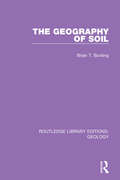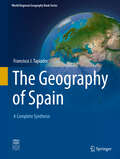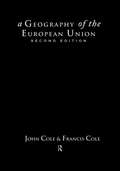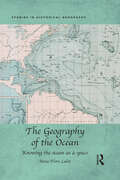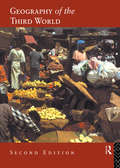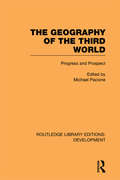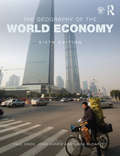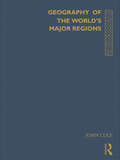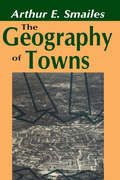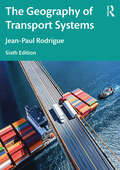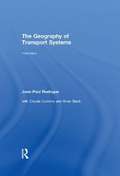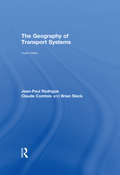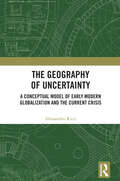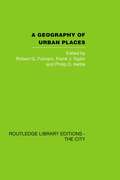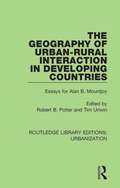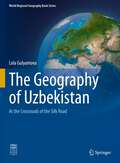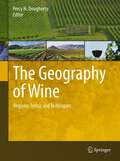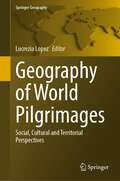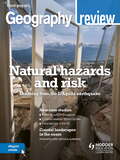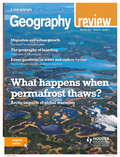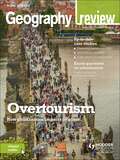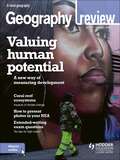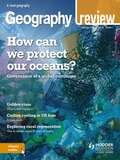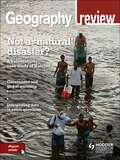- Table View
- List View
The Geography of Soil (Routledge Library Editions: Geology #10)
by Brian T. BuntingThis book, first published in 1965, was the first by a British soil expert in which he wrote a study of his subject from a geographical, not an agricultural or biological, viewpoint. Chapters 1-8 deal with the factors and processes in soil formation. Chapters 9-17 describe the soil groups of the different regions of the world – for example, desert and tundra, the boreal zone, the Mediterranean, and intertropical areas.
The Geography of Spain: A Complete Synthesis (World Regional Geography Book Series)
by Francisco J. TapiadorThis book is the latest and most comprehensive reference to the regional geography of Spain, taking into account emergent issues such as biodiversity, climate change and nationalism. It appeals to scientists as well as to students and instructors and all fields of geography, regional, environmental and cultural studies, and business related disciplines. It covers the whole range of topics from the physical to the human geography of Spain and provides detailed insights into all 17 autonomous communities. Dozens of GIS maps and hundreds of photographs and images including remote sensing imagery make this volume a must have for every geography department.
The Geography of Strabo
by Duane W. RollerThe Geography of Strabo is the only surviving work of its type in Greek literature, and the major source for the history of Greek scholarship on geography and the formative processes of the earth. In addition, this lengthy and complex work contains a vast amount of information on other topics, including the journey of Alexander the Great, cultic history, the history of the eastern Mediterranean in the first century BC, and women's history. Modern knowledge of seminal geographical authors such as Eratosthenes and Hipparchos relies almost totally on Strabo's use of them. This is the first complete English translation in nearly a century, and the first to make use of recent scholarship on the Greek text itself and on the history of geography. The translation is supplemented by a detailed discussion of Strabo's life and his purpose in writing the Geography, as well as the sources that he used.
A Geography of the European Union
by John ColeCan the European Union continue to grow and also converge? Is uniformity within the union desirable? The European Union has grown into a supranational entity formed from a mosaic of diverse regions. Its enlargement to encompass a number of Central European countries seems only a matter of time. With the EU's political and economic importance growing globally, the Union's influence is increasingly being felt within its Member States. A new geography is emerging with pressures to reduce regional disparities by a process of convergence. A Geography of the European Union provides a comprehensive introduction to the European Union, its identity, problems and prospects. Focusing on the key issues of integration and enlargement, the authors examine the major economic, social, environmental and political aspects of the EU, both in terms of its individual regions and as a system of interdependent states that form the single EU entity. Assessment of controversial issues is frank: problems of unemployment, social stress, ageing and the place of women are covered objectively, prompting readers to form their own interpretations. This completely revised and expanded 2nd Edition includes a wealth of new illustrations, data and analysis. Setting the EU within a broader European and global context, this book provides a comprehensive introduction to the changing geography of the European Union and its place in a rapidly changing world.
The Geography of the Ocean: Knowing the ocean as a space (Studies in Historical Geography)
by Anne-Flore LaloëDespite the fact that the vast majority of the earth’s surface is made up of oceans, there has been surprisingly little work by geographers which critically examines the ocean-space and our knowledge and perceptions of it. This book employs a broad conceptual and methodological framework to analyse specific events that have contributed to the production of geographical knowledge about the ocean. These include, but are not limited to, Christopher Columbus’ first transatlantic journey, the mapping of nonexistent islands, the establishment of transoceanic trade routes, the discovery of largescale water movements, the HMS Challenger expedition, the search for the elusive Terra Australis Incognita, the formulation of the theory of continental drift and the mapping of the seabed. Using a combination of original, empirical (archival, material and cartographic), and theoretical sources, this book uniquely brings together fascinating narratives throughout history to produce a representation and mapping of geographical oceanic knowledge. It questions how we know what we know about the oceans and how this knowledge is represented and mapped. The book then uses this representation and mapping as a way to coherently trace the evolution of oceanic spatial awareness. In recent years, particularly in historical geography, discovering and knowing the ocean-space has been a completely separate enterprise from discovering and colonising the lands beyond it. There has been such focus on studying colonised lands, yet the oceans between them have been neglected. This book gives the geographical ocean a voice to be acknowledged as a space where history, geography and indeed historical geography took place.
A Geography of the Third World
by C. G Clarke Dr J Dickenson J. P Dickenson W.T.S Gould S Mather Sandra Mather Prof R Prothero R. M Prothero D. J Siddle C. T Smith Mr C Smith E. Thomas-HopeThe label of "Third World" covers half the land surface and three quarters of the population of the planet. The problems and potential of this region and its peoples are attracting increasing concern and interest.Fully revised and updated this edition includes: * a wealth of photographic and line illustrations* boxed case studies* chapter summaries* guides to further readingIssues of increasing concern at the end of the twentieth century are fully addressed - for example, the widening gap in economic performance between countries in the Third world and the assertion of national cultures in the face of globalisation. New material on gender issues and the environmental impact of development has been included.
The Geography of the Third World: Progress and Prospect (Routledge Library Editions: Development)
by Michael PacioneFirst published in 1988, this reissue presents a comprehensive overview of contemporary developments and research into the geography of the Third World, at a time when economies and societies there were changing at a much more rapid rate than their counterparts in the developing world. It covers the topic both systematically and by region, showing how the unique background of each region affects developments there.
The Geography of the World Economy: An Introduction To Economics Geography
by Linda Mccarthy Paul Knox John A AgnewThe Geography of the World Economy provides an in-depth and stimulating introduction to the globalization of the world economy. The book offers a consideration of local, regional, national and global economic development over the long historical term. The theory and practice of economic and political geography provide a basis for understanding the interactions within and among the developed and developing countries of the world. Illustrated in color throughout, this new edition has been completely reworked and updated to take account of recent significant changes in the world economy. A new companion website also accompanies the book, with additional resources for each chapter including multiple choice and short essay questions and links to relevant websites. Figures and tables are also available for download located at www.routledge.com/cw/knox The text is signposted throughout with an glossary of key terms, and is richly illustrated with full-color maps, diagrams and illustrations. It is ideal for upper level university undergraduates and for post-graduates in a variety of specializations including geography, economics, political science, international relations and global studies.
Geography of the World's Major Regions
by John ColeThis volume presents a global view of today's most pressing issues through an analysis of the twelve major regions of the world. Environmental degradation, natural catastrophe, population pressures and human conflict all impact in different ways and to different degrees on the society and environment of these regions. Economic and political restructuring within each region is covered, and topics include: natural resources; agriculture; industry and services; the role of the military; and the impact of global economic change. This work is intended as an introduction for students studying the changing geography of the world, but should also provide a useful overview to students researching specific regions, seeking comparative analysis of regions, or following general courses on the economic and political geography of both the post-industrial and the developing worlds. Over 250 photographs, maps and figures complement a range of boxed case-studies, key points, questions and guides to further reading.
The Geography of Towns
by Arthur E. SmailesWhen first released much praise was given to this book: "An outstanding book on urban geography. . . representative of the best on this subject."--Higher Education Journal"The book ought to be required reading for every planner and student of planning . . . a magnificent achievement." --Town and Country Planning.The Geography of Towns provides a concise but thorough introduction to the important subject of urban geography. It traces the development of urban areas from the earliest sites of Nineveh, Aleppo, and Agade to modern megalopolises and strip cities, and deals authoritatively with problems of classification and ranking, location and type, origins, and course of development, and the relationship of the city to its region and nation.All facets of urban geography are covered, including the core, integuments, population structure, land-use patterns, enclaves, and town structure. Population mobility and the continual crisscross circulation of populations within and between town and region are seen as important forces affecting the internal geography of towns. The author questions the usefulness or validity of such terms as "neighborhood" and stresses the need for more meaningful conceptualizations and vocabulary.One of the fundamental problems connected with urban geography is to assist in the planning of future cities. This book contributes substantially to an understanding of the interrelations of town and region and to an understanding of the components of the city itself which are essential to intelligent planning for the future.
The Geography of Transport Systems
by Jean-Paul RodrigueThis expanded and revised sixth edition of The Geography of Transport Systems provides a comprehensive and accessible introduction to the field with a broad overview of its concepts, methods, and areas of application. It explores the spatial aspects of transportation and focuses on how the mobility of passengers and freight is linked with geography.The book is divided into ten chapters, each covering a specific conceptual dimension, including networks, modes, terminals, freight transportation, urban transportation, and environmental impacts, and updated with the latest information available. The sixth edition offers new and updated material on information technologies and mobility, e-commerce, transport and the economy, mobility and society, supply chains, security, pandemics, energy and the environment, and climate change. With over 140 updated figures and maps, The Geography of Transport Systems presents transportation systems at different scales ranging from global to local.This volume is an essential resource for undergraduates studying transportation, as well as those interested in economic and urban geography, transport planning and engineering. A companion website, which contains additional material such as photographs, maps, figures, and PowerPoint presentations, has been developed for the book and can be found here: https://transportgeography.org/
The Geography of Transport Systems
by Jean-Paul Rodrigue Claude Comtois Brian SlackMobility is fundamental to economic and social activities such as commuting, manufacturing, or supplying energy. Each movement has an origin, a potential set of intermediate locations, a destination, and a nature which is linked with geographical attributes. Transport systems composed of infrastructures, modes and terminals are so embedded in the socio-economic life of individuals, institutions and corporations that they are often invisible to the consumer. This is paradoxical as the perceived invisibility of transportation is derived from its efficiency. Understanding how mobility is linked with geography is main the purpose of this book. The third edition of The Geography of Transport Systems has been revised and updated to provide an overview of the spatial aspects of transportation. This text provides greater discussion of security, energy, green logistics, as well as new and updated case studies, a revised content structure, and new figures. Each chapter covers a specific conceptual dimension including networks, modes, terminals, freight transportation, urban transportation and environmental impacts. A final chapter contains core methodologies linked with transport geography such as accessibility, spatial interactions, graph theory and Geographic Information Systems for transportation (GIS-T). This book provides a comprehensive and accessible introduction to the field, with a broad overview of its concepts, methods, and areas of application. The accompanying website for this text contains a useful additional material, including digital maps, PowerPoint slides, databases, and links to further reading and websites. The website can be accessed at: http://people.hofstra.edu/geotrans This text is an essential resource for undergraduates studying transport geography, as well as those interest in economic and urban geography, transport planning and engineering.
The Geography of Transport Systems
by Jean-Paul Rodrigue Claude Comtois Brian SlackThis expanded and revised fourth edition of The Geography of Transport Systems provides a comprehensive and accessible introduction to the field with a broad overview of its concepts, methods and areas of application. Aimed mainly at an undergraduate audience, it provides an overview of the spatial aspects of transportation and focuses on how the mobility of passengers and freight is linked with geography. The book is divided in ten chapters, each covering a specific conceptual dimension, including networks, modes, terminals, freight transportation, urban transportation and environmental impacts, and updated with the latest information available. The fourth edition offers new material on the issues of transport and the economy, city logistics, supply chains, security, energy, the environment, as well as a revised content structure. With over 160 updated photographs, figures and maps, The Geography of Transport Systems presents transportation systems at different scales ranging from global to local and focuses on different contexts such as North America, Europe and East Asia. This volume is an essential resource for undergraduates studying transport geography, as well as those interested in economic and urban geography, transport planning and engineering. A companion web site, which contains additional material, has been developed for the book and can be found here: http://people.hofstra.edu/geotrans/
The Geography of Uncertainty: A Conceptual Model of Early Modern Globalization and the Current Crisis
by Alessandro RicciThis book outlines the characteristics and implications of a potential geography of uncertainty. In doing so, it analyses this concept in reference to both the origins of uncertainty in Early Modern Age and the current geopolitical situation. The book adopts an interdisciplinary approach to uncertainty, drawing on global perspectives and literature to define its meanings and characteristics. In order to develop a thorough and precise understanding of the geography of uncertainty, a broad perspective is adopted, which includes other forms of knowledge in which the concept of uncertainty is firmly established. As such the book creates temporal links, that may occasionally be far off from one another, to present a geographical perspective of uncertainty. It provides an interpretation of the phenomenon of globalization in a new way, relating it to the first European openness to global spaces, the Early Modern Age, and identifying the transition from the medieval world to the Modern Age as the first manifestation of uncertainty in geography. Uncertainty is more prevalent than ever in today's geopolitical, economic, financial and social reality, as well as the ongoing emergencies and crises. The book adopts an interdisciplinary approach rooted in the geography of Early Modernity by referring to geopolitical scenarios, literature and philosophy, to target the historical roots and the prevailing configuration of the geography of uncertainty. It will appeal to scholars and students of human and political geography, politics, philosophy, international relations, economics and history.
A Geography of Urban Places (Routledge Library Editions)
by Robert G. Putnam Frank J. Taylor Philip G. KettleThis book presents a selection of readings to present varied opinions, approaches and reports from various international professional journals. Among the journals represented are: Regional Science Association Journal, The Canadian Geographer, The Annals of the American Association of Geographers, Economic Geography, Landscape, Journal of Soil and Water Conservation and Land Economics. This book was first published in 1970.
The Geography of Urban-Rural Interaction in Developing Countries: Essays for Alan B. Mountjoy (Routledge Library Editions: Urbanization #7)
by Robert B. Potter Tim UnwinOriginally published in 1989, The Geography of Urban-Rural Interaction in Developing Countries addresses the nature and importance of the interaction between ‘urban’ and ‘rural’ areas within Third World national territories, providing much-needed comparative, cross-cultural, and cross-national material. The book discusses the various theories of urban-rural interaction, and summarises the topic in the form of the movement of people, goods, money, capital, new technology, energy, information and ideas. Case studies are drawn from different areas of the Third World – including Africa, Asia, the Middle East, and the Caribbean and illustrate in detail the nature of urban-rural interaction.
The Geography of Uzbekistan: At the Crossroads of the Silk Road (World Regional Geography Book Series)
by Lola GulyamovaThis book describes the geography of Uzbekistan and its unique history and culture. It focuses on the development of Uzbekistan as a result of its location on the crossroads of the Silk Road. The influence of global and regional environmental challenges on the current landscape and similar issues are discussed and analyzed from a historical perspective. Contemporary tensions and reforms in social, economical and cultural life are described with the aim to draw a picture of modern paths to transformation and development. The Geography of Uzbekistan includes also information on geology, nature and natural resources, in particular water. The book discusses the social and environmental impacts of the Aral Sea disaster and shows new paths of transformation and development for this Central Asian country.
The Geography of Wine
by Percy H. DoughertyWine has been described as a window into places, cultures and times. Geographers have studied wine since the time of the early Greeks and Romans, when viticulturalists realized that the same grape grown in different geographic regions produced wine with differing olfactory and taste characteristics. This book, based on research presented to the Wine Specialty Group of the Association of American Geographers, shows just how far the relationship has come since the time of Bacchus and Dionysus. Geographers have technical input into the wine industry, with exciting new research tackling subjects such as the impact of climate change on grape production, to the use of remote sensing and Geographical Information Systems for improving the quality of crops. This book explores the interdisciplinary connections and science behind world viticulture. Chapters cover a wide range of topics from the way in which landforms and soil affect wine production, to the climatic aberration of the Niagara wine industry, to the social and structural challenges in reshaping the South African wine industry after the fall of apartheid. The fundamentals are detailed too, with a comparative analysis of Bordeaux and Burgundy, and chapters on the geography of wine and the meaning of the term 'terroir'.
Geography of World Pilgrimages: Social, Cultural and Territorial Perspectives (Springer Geography)
by Lucrezia LopezThis book points out how pilgrimage studies rely on interdisciplinary academic interests, being always more determined by anthropological, social, cultural and economic factors. The volume gathers interdisciplinary contributions revealing different approaches and academic interests when researching pilgrimage. Finally, the proposal introduces a comparative international breath to reflect upon such complex phenomenon that since Antiquity still impregnates the history of human being across the world. As pilgrimage studies are closely related to mobility issues, how the contemporary mobile world is altering and re-signifying pilgrimage dynamics and meanings will also be discussed in detail. The term “pilgrimage” evokes key concepts deriving from different fields, all of them collected in the final glossary.The primary audience of this work are academics and researchers from different fields involved in pilgrimage studies. The work may also be useful in teaching (advanced) university courses.
Geography Review Magazine Volume 32, 2018/19 Issue 1
by Hodder Education MagazinesThis A-level geography magazine provides topical articles by experts in the field, specifically written for students to help them gain the highest grades. With up-to-date articles and case studies, it also includes advice on the NEA and approaching exam questions.ContentsHazard perception and risk: learning from the L'Aquila earthquake Noel Castree Question and answer Coastal landscapes and change Geographical ideas Representation David Redfern Achieving water security: a case study of Singapore Yvonne Follows-Smith Everybody's talking about... Premature deindustrialisation Simon Oakes Centrepiece Life expectancy in England: a north-south journey Clare Bambra and Chris Orton Storm Ophelia: a UK case study of extreme weather Sylvia Knight NEA ideas Researching inequality Martin Evans Global governance Getting to grips with global norms Simon Oakes Do food banks help? Food insecurity in the UK Jon May, Andrew Williams, Paul Cloke and Liev Cherry El Niño and La Niña: understanding extreme weather George Adamson Geographical skills How to use qualitative data: researching place with images and oral histories David Holmes The big picture The death of the Arctic? Jamie Woodward
Geography Review Magazine Volume 32, 2018/19 Issue 2
by Hodder Education MagazinesContents:Australia's migrants: impacts on urban growthIain MeyerQuestion and answerWater and carbon cyclesThe permafrost carbon feedback: the impact of global warming on Arctic ecosystemsPhilip WookeyThe equality of water supply in Lilongwe: a resource-security case studyNoel CastreeCentrepieceEarth's changing climateEd HawkinsAdapting to climate change: an agricultural case study from Nepal Mary Peart and Morgan PhillipsGlobal development update Modern slavery: an issue of global governanceGill MillerGeographical ideasInequalitySimon OakesThe geography of branding: using place to sell productsAndy PikeGeographical skillsHow to use qualitative data: researching place with interviews and social mediaDavid HolmesNEA ideasResearching place and brandingMartin EvansThe big pictureWhy are Africa's oldest baobabs dying?Jamie Woodward
Geography Review Magazine Volume 32, 2018/19 Issue 3
by Hodder Education MagazinesContents for this issue:Changing the meaning of place: a rebranding case study of Park Hill Flats, SheffieldQuestion and answerGlobal urbanisationEverybody's talking about...OvertourismRiver ecosystems: why do they matter?Geographical ideasCausalityCentrepieceWorlds of wealthMeasuring diversity of place: a case study of LondonThe global e-waste tradeCarbon updateGreenhouse gases: monitoring for mitigationWater security across borders: two international case studiesGeographical skillsUsing photos as evidence in your NEA: getting the picture rightNEA ideasChanging placesThe big pictureCan we tackle the ocean plastics problem?
Geography Review Magazine Volume 32, 2018/19 Issue 4
by Hodder Education MagazinesContents for this issue: Coral reef ecosystems: monitoring climate changeQuestion and answerExtended writing: ten tips for quality answersWhat happens to your rubbish? The geography of wasteFood security in Detroit: a case studyNEA ideas?Measuring surface roughness in natural systemsGeographical ideasInterdependenceCentrepieceCan London become a National Park?Geographical skillsUsing photos as evidence in your NEA: presenting and interpreting imagesWetlands in drylands: understanding dynamic environmentsGlobal development updateInternational trade: changing approachesMaking connectionsGlaciation, climate change and tectonic hazardsMeasuring development: can we improve on GDP?Index to Volume 21The big pictureDestroying the sense of place in Venice
Geography Review Magazine Volume 33, 2019/20 Issue 1
by Hodder Education MagazinesContents: Managing the world's oceans Clive Schofield and Noel Castree Question and answer Regeneration and deprivation Making connections Hazard and place David Redfern Golden visas: how elite migration works David Ley Everybody's talking about 5G Simon Oakes Global development update Changing gender equality Alice Evans Centrepiece Protecting the high seas Olive Hefferman Floodplain fens: a case study of carbon cycling Kate Heppell et al. Carbon update Global temperature targets: do they work? Noel Castree Platform capitalism and globalisation Daniel Whittall Glaciated limestone landscapes: landforms and processes Jamie Woodward and Philip Hughes Geographical skills Researching literature for your NEA David Holmes and Matt Smith NEA ideas Hazard and place Martin Evans The big picture Restoring peatlands as a carbon store Martin Evans
Geography Review Magazine Volume 33, 2019/20 Issue 2
by Hodder Education MagazinesContents:Human vulnerability to 'natural' disasters: a case study of Hurricane KatrinaChristine EriksenQuestion and answerWhy have I been given this? Ten tips to improve data interpretationHow can we manage global warming?Noel Castree and Rob BellamyMaking connectionsLandscapes, climate and diseaseDavid RedfernGeography worksFrom geography degree to NHS managementSir Andrew DillonCarbon updateCarbon in the river systemClaire GoulsbraCentrepieceThe Hong Kong-Zhuhai-Macau megabridgeOllie DaviesRestoring peatlands: can increasing a carbon store help us manage floods?Martin EvansGlobal trade patterns: how are they changing?Jessie PoonGlobal governance updateScales of governance: climate policy in the USASimon OakesAge segregation and place: social inequality in the UKAlbert SabaterGeographical skillsGetting your sampling rightDavid HolmesNEA ideasAge segregationMartin EvansThe big pictureAgriculture and water pollutionNoel Castree
